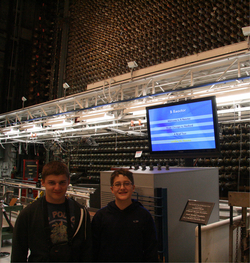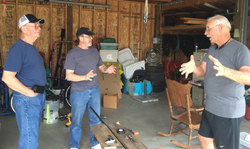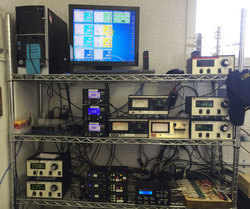 December 30, 2015 Editor: Paul Bourque, N1SFE | ||||||
IN THIS ISSUE
NEW HF OPERATORS - THINGS TO DO
New Year's Eve, some party-hopping could be in order. You could start with the AGB New Year Snowball Contest, catch one (or both) of the NCCC Sprints, make a couple of Q's in the ARRL Straight Key Night, ring in your New Year locally and efficiently, as the SARTG New Year RTTY Contest starts 0800 UTC January 1. You can switch to the AGCW Happy New Year Contest until 1200 UTC, power nap for three hours, then do the QRP ARCI New Years Sprint. Do something else for a few hours, but be back at the radio on January 2, 1800 UTC for the ARRL RTTY Roundup. A good way to set the pace for contesting in 2016 - sleep is for when there are no contests. The next weekend, the twelve hour NAQP CW is always a good bet as contest entries are all 100 watts. Team participation can add another layer of fun to the event. "I am proud to announce that student registration is now open for 2016 Dayton Contest University ("CTU") to be held all day on Thursday May 19, 2016 at the Crowne Plaza in Dayton, Ohio. http://contestuniversity.com" - Tim, K3LR
Don't forget about the National Parks on the Air operating event starting January 1, 2016. It's a year-long event, and there are leader boards, certificates, and so on. BUSTED QSOS Rich, K3VAT, points out that the first wave of USB 3.0 enabled products appeared on the market in 2010. Complete information for all contests follows the Conversation section December 31 January 1
January 2 January 3 January 5 January 6 January 7 January 8 January 9 January 10
January 13 ARRL Straight Key Night is January 1. While not a contest, it's a fine opportunity to send (and receive) CW the way it was done originally, forming the dots and dashes by hand. Perhaps a hipster take on it would be "Artisanal CW." The Straight Key Century Club (SKCC) promotes and preserves the straight key tradition all year long, though for their purposes the definition of straight key also includes bugs and sideswipers. SKCC emphasizes the correct CW etiquette & protocols, and has an active mentoring program for CW skills improvement. Check out their web site for their operating events, awards, and all manner of key related information. It's only fun until someone experiences RFI: AM Broadcasters affected by RFI issues: AFCCE Symposium Examines AM Broadcast Band Woes . AM broadcasters are calling upon the FCC to help reduce man-made RFI, which is negatively impacting their businesses. (Mark, K6UFO) Conventional wisdom has been proven wrong once again after application of scientific rigor: Tin foil hats make it EASIER to receive government signals . An unanticipated side effect of this research is it could be harder to recognize those individuals attempting to avoid those signals. (Ward, N0AX) It's becoming harder and harder to immediate local sources of electronics parts in most areas - here is one person's observation of the current-day electronic surplus store situation in Texas, with some observations of changes over time . (Tim, K3HX) Web Site of the Week - cryptomuseum.com This site hosts a diverse assortment of information, including a section on radio equipment related to military, covert, or encrypted communication. I'm a better-informed hamfest shopper after reviewing some of the pictures of the primarily olive-drab colored radios. "Bonking" - Analogous to "hitting the wall," when one just runs out of energy to continue. "I was on the 10 meter position on the 2nd night, and after CQing into a dead band for the 6th straight hour, I just bonked." A drone might be able to help visualize your antenna and tower relationships. Here's a spectacular video tour of VE6JY's antenna farm. 4O3A hosted a number of young contesters for the CQWW RTTY 2015 contest. Here's an opportunity to see some of the operators you've been working. When it comes to drones, it can take two, and a net, to catch one. Also, don't forget that as of December 21, 2015, you may need to register to fly your drone. AA4XX participated in the ARRL 160m contest with a QRP entry, but it had much of the excitement of a one-person DXpedition with boats, beaches, tents, and tides. As the year closes, we are reminded of the Retro Encabulator. (David, WA1OUI) WRTC-2018 Qualifier "Leader board" - Entered a contest in the last few months? You may be on the list! (Ulf, DL5AXX) The CQ WW Contest Committee did a survey in the month of September, and the some of the results have been released. It's worth a look if you're interested in the demographics of our hobby. OPERATING TIP - Move around while operating While "butt in chair" is the phrase used to emphasize consistent and prolonged operating time, what you really need to do is stay operating, regardless of your body position. You can remain operating, but stand up or move around, if you get a longer headset cord, or otherwise plan ahead. By getting out of your seat, you'll be reducing the chances of getting Deep Vein Thrombosis (DVT), and be increasing your overall alertness. Add 'getting out of your chair' or 'standing up' to your skillset - whether it's a couple of times an hour, each time you evaluate changing bands, or in response to some other cue (every new mult?). Gamify it if necessary. Vacuum tubes are still relevant, and innovation is still happening to improve performance characteristics, in certain parts of the tube market. (N7SS via N0AX) Low-voltage relay driver boards are inexpensive and widely available via eBay, as many Arduino projects use these. They can work great for automating various pieces of equipment in your shack, such as antenna switches, filter/stub switching, and the like. Search for "Arduino relay driver board" on eBay. Digital cameras of the future may not need lenses, or look much like today's cameras, given Rice University's research into "FlatCams." Surfaces (curved or flat) can be covered in a sensor film, and images are 'computed' from the data collected by the sensor. It is similar to a light field camera, and analogous to capturing a wide swath of RF bandwidth and detecting the signals of interest after the fact. Many of the manufacturers of the devices we use every day don't want us to be able to fix the devices ourselves, and use specialized fasteners, sealers, and other mechanisms to keep us out of them. Here are some of the techniques and tools you might need to get into your device. Remote Operation for Contesting, Part 1 Remote operation of an Amateur Radio station has become more common in the last few years. Remote operation solves problems that some hams have with antenna restrictions, high local RF noise levels, physical challenges, and allow people to be on the air when they otherwise wouldn't. The availability of an always-on link via the Internet, ever faster and cheaper computers and hardware, and more control and communications functionality built into our gear has made it almost trivial to set up for common scenarios. Early remote stations ("remote bases") used microwave and/or telephone links to support control and communication, and involved custom equipment, challenging setup, and sometimes variable reliability. Today, it is possible to set up and use a remote equipped with just a ham license and a credit card. Individual operator opinions on the use of remotes are varied, and it's easy to find many email and forum messages expounding on how the widespread availability has, is about to, or may affect general ham radio positively, negatively, or neutrally. Contesting is always looking for new ways to find stations to work faster, attain higher rates, make bigger scores, participate in more contests. Any technique or technology that can help attain those goals is evaluated, then kept or discarded. If you read the post-contest ("soapbox") contest score comments (as you should to mine nuggets of information that can help in your contesting efforts), the word "remote" is being used more frequently, especially in the last year. I've asked some of the contest operators noting remote operation to comment on why they're setting up remotes, what they expect to get out of it, how they expect it will affect their contest participation. And if they've had some major contest experiences already via remote, what happened that they didn't expect. In future issues of the Contest Update, I'll continue to present remote contesting related comments here. Multi-operator use demands care through all aspects of planning, building, and maintenance. Now add in remote capability... as the crew of the K7JR / Snake River Remote Contesters Club did recently as they remoted the already-highly-capable station of Joe Rudi, NK7U located in Baker City, Oregon. Scott Tuthill, K7ZO, was generous in his explanation of what they did, and why:
"Joe, NK7U has had a multioperator capable contest station at his various QTH's in Baker City Oregon since the late 1970's. Joe has always liked the challenges of building such a station and the camaraderie that multi-operator contesting brings. It is the contesting experience that most closely has the team feeling that Joe enjoys. Over the past 10 years though it has become increasingly harder to assemble a team in Baker City. Most importantly NK7U himself has started spending a good portion of the year, during key contest months, down south to escape the cold Baker City winters. This more than anything has been the driving impetus to develop a multi-operator remote contest station. Also by creating a remote environment it has allowed us to bring in new members and retain old ones who just don't have the time to make the trip to Baker City for a contest weekend. Thus was born the Snake River Remote Contesters Club (SRRCC) using the callsign, K7JR.
Initial experiments with remote access to the NK7U station began in late 2007. Scott, K7ZO hooked up a TS-480 to one side of the Six-Pack antenna matrix in Baker, controlling it with TRX-Manager, Skype, and various remote desktop solutions. This was fine for his casual DX-ing and the random single operator low power contest operations. In the last few years as NK7U started travelling more, and also wanted access, he was looking for a more traditional physical Front Panel user interface. About this time a couple other things came together. Kevin, K7ZS came onto the scene with his increased level of technical expertise. And, vendors started introducing important building blocks from which to build a remote station. In our case the Elecraft K3 & K3/0 Mini, RemoteRig RRC-1258, and Hamation station control. With these building blocks, and a lot of hard work by K7ZS, we had a single op remote station up and running in late 2014 and by CQWW SSB 2015 a complete M/2 or M/S capable remote contest station at the NK7U site. The SRRCC team made a M/2 entry in the 2015 CQWW SSB as K7JR. We have had several other multi-operator and single operator activations since then in SSB, CW, and RTTY modes. " What were the reasons that caused you to remote now? "Though the reasons have been building for years, the one that really caused the push was Joe, NK7U spending winters down south. That and the technical solutions became available and we had someone, K7ZS, who could put it all together." How do you anticipate having remote operation will affect your contest efforts? "I would say we are still learning this. For sure it has allowed us to participate more frequently in contests because it eliminates the travel requirement to Baker City. And, remember the distances out west are long. The closest operator lives two and a half hours away, most live five hours away, and another nine. And, during contest high season winter weather frequently closes roads and/or makes travel unsafe. The technology provides us with a SO, M/S, or M/2 environment just like being in Baker, that is not a limiting factor. (Other than we have to substitute on-line chat for being able to yell at someone across the room.) What is different is that by not traveling to the contest station, and being dedicated to the event for the weekend, it seems like it is harder to create a full bore entry. By operating from home, operators are subjected to the normal daily distractions and interruptions. Whereas the challenge of a contest in Baker was to make sure all the operators got enough and equal time on the air, in a remote setting is it making sure we can get the station staffed for the contest hours. Maintaining and operating the remote station also requires a whole new set of documentation, standard operating procedures, etc. This is both because of the added level of complexity to be part of the remote network but also that operators are not as familiar with the station itself. We have one operator who has never been to the actual QTH. And many of the operators have never met. So, the interpersonal side of the contest team is becoming the interesting one to sort out." What benefit do you expect to get from enabling remote operation? "The K7JR, SRRCC team, fully expects to be on the air in more contests as a result of the remote capabilities. The NK7U station will be used and generate contest QSOs where it would not before. There is no question about that. Where we go seems to be more driven now by the interests, motivations, and desires of the team members than the technology itself. That is a monumental change from probably only three years ago." Any other thoughts?
What has really come together in the last three years are the "glue" pieces in relatively easy to implement building blocks - meaning you don't have to do your own design, assembly, and programming of fairly low level hardware control. For instance:
Thanks Scott! Happy New Year! Brian N9ADG DATE An expanded, downloadable version of QST's Contest Corral in PDF format is available. Check the sponsor's Web site for information on operating time restrictions and other instructions. HF CONTESTS CWops Mini-CWT Test , Dec 30, 1300z to Dec 30, 1400z, Dec 30, 1900z to Dec 30, 2000z, Dec 31, 0300z to Dec 31, 0400z; CW; Bands: 160, 80, 40, 20, 15, 10m; Member: Name + Member No., non-Member: Name + (state/province/country); Logs due: January 2. VHF+ CONTESTS AGCW VHF/UHF Contest , Jan 1, 1400z to Jan 1, 1700z (144), Jan 1, 1700z to Jan 1, 1800z (432); CW; Bands: 144 MHz, 432 MHz; RST + "/" + Serial No. + "/" Power class + "/" + 6-character grid locator; Logs due: January 18. 31 Dec 2015 - 13 Jan 2016
December 31, 2015 January 1, 2016 January 2, 2016 January 5, 2016 January 10, 2016 January 11, 2016 January 12, 2016 ARRL Information Click here to advertise in this newsletter, space subject to availability. Your One-Stop Resource for Amateur Radio News and Information ARRL membership includes QST, Amateur Radio's most popular and informative journal, delivered to your mailbox each month. Subscribe to NCJ - the National Contest Journal. Published bimonthly, features articles by top contesters, letters, hints, statistics, scores, NA Sprint and QSO Parties. Subscribe to QEX - A Forum for Communications Experimenters. Published bimonthly, features technical articles, construction projects, columns and other items of interest to radio amateurs and communications professionals. Free of charge to ARRL members: Subscribe to The ARRL Letter (weekly digest of news and information), the ARES E-Letter (monthly public service and emergency communications news), Division and Section news -- and much more! ARRL offers a wide array of products to enhance your enjoyment of Amateur Radio. Visit the site often for new publications, specials and sales. Donate to the fund of your choice -- support programs not funded by member dues! Reprint permission can be obtained by sending email to permission@arrl.org with a description of the material and the reprint publication. ACKNOWLEDGEMENTS ARRL Contest Update wishes to acknowledge information from WA7BNM's Contest Calendar and SM3CER's Contest Calendar. | ||||||











